These are a few examples of the types of things that can provide for a rich and effective training in the art of surgery. Many of these are simulators; these can also be considered part of skills development and may be listed in that section. Although these have limitations (’tissue’ handling is not similar to the real thing; there is no realistic bleeding, something which often intimidates the novice), they have been shown (see citations in the literature section below) to be effective in increasing a person’s dexterity and some can familiarize the person with the anatomical aspects of a particular surgical procedure. Others involve using cadavers, which provide for a somewhat more realistic experience, or using live animals who will benefit from the surgery such as patients in the operating theater or those being sterilized as part of an animal shelter program. The latter is an important method of providing live animal experience and training in many core skills needed to perform surgery. The experience at many institutions using this has been positive for students and animals alike (eg see Clevenger & Kass, 2003; Freeman et al 2013; Freeman et al 2014; Kennedy et al 2011; Smeak, 2007; Snowden et al 2008; Spindel et al 2008).
New additions:
Development and Validation of an Equine Castration Model and Rubric
Development and Validation of a Uterine Prolapse, Epidural, and Vaginal Suture Model
Following the list of specific alternatives, there is a section comprising literature that either explains or evaluates the alternatives or provides additional information on the subject of surgical instruction.
If you are aware of other examples you believe to be important to include here, please send the information to HEVM for consideration.
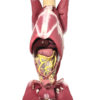 |
Available from SynDaver Labs.
From Web site: The SynDaver Synthetic Canine is a futuristic animal model designed to replace live animals and animal cadavers in veterinary surgical training. Based on 20+ years of SynDaver research, this model is made from water, fiber and salt. She is a life saver, but she is not alive. She breathes and bleeds just like a real dog. She has individual muscles, bones, and organs – and can be operated on repeatedly without risking a live animal.
See use and evaluation of this simulator by Casimir et al 2023, at Tuskegee University.
Body Wall
This is a realistic simulation of the body wall. It allows incisions to be made and sutured with realistic simulated bleeding.
See Colorado State University Invention Helps Students Learn Surgical Techniques Before Operating on Patients for a description.
See Colorado State University Develops Artificial Tissue for a video illustrating the medium.
DASIE™ Dog Abdominal Surrogate for Instructional Exercise
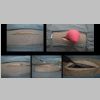 |
See Holmberg et al 1993 for evaluation.
SimSpay
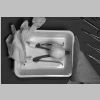 |
This is a simple, easily and economically built simulator that can provide some of the essential psychomotor skills necessary for this surgery.
Described and evaluated in Langebæk et al 2015.
Dog abdomen, ovariohysterectomy simulator
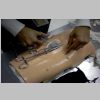 |
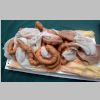 |
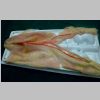 |
This appears to be an effective means of preparing the student for ovariohysterectomy in the living animal.
Developed by University of Sydney, Faculty of Veterinary Science, Sydney, Australia with Studio Kite; see article by Woon for more information.
TheMOOSE, ovariohysterectomy simulator
 |
This is described and evaluated by Fahie et al 2016.
Spay Training Manikin (ovariohysterectomy)
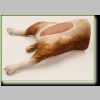 |
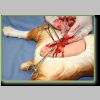 |
From Web site: The manikin allows the student to recreate a lifelike, step by step training, from incision to sutures.
Produced by Vet Effects Incorporated.
Manikin – Spay Dog (ovariohysterectomy)
 |
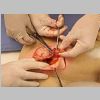 |
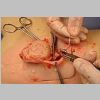 |
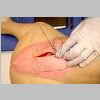 |
From Web site: The Spay Manikin was designed by Paws 2 Claws to be hands on training aid in learning the surgical procedures and techniques of spaying a dog, from intubation to the final sutures.
Available through Paws 2 Claws™.
Kattrappen simulator for feline ovariohysterectomy
 |
This appears to be an effective means of preparing the student for ovariohysterectomy in the living animal.
Developed by veterinarians in Sweden; see article for more information.
Canine Laparoscopic Ovariectomy Model
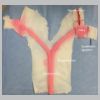 |
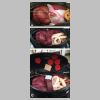 |
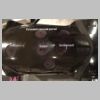 |
Described by Chen et al 2019.
Neuter Training Manikin (castration)
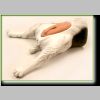 |
 |
From Web site: The manikin allows the student to recreate a lifelike, step by step training, from incision to sutures.
Produced by Vet Effects Incorporated.
Manikin – Neuter Dog (castration)
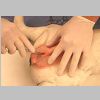 |
 |
 |
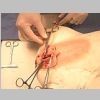 |
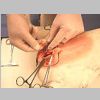 |
From Web site: The Neuter Manikin was designed by Paws 2 Claws to be hands on training aid in learning the surgical procedures and techniques of neutering a dog, from intubation to the final sutures.
Available through Paws 2 Claws™.
Canine Ovariohysterectomy (Spay) Model
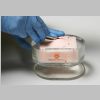 |
 |
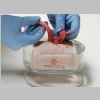 |
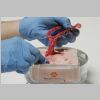 |
Produced by Rescue Critters!
Canine Orchiectomy (Neuter) Model
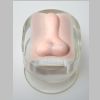 |
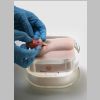 |
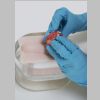 |
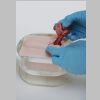 |
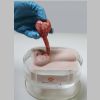 |
Produced by Rescue Critters!
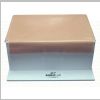 |
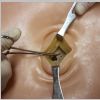 |
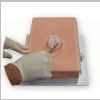 |
From Web site: The laparotomy model simulates a partial abdomen and includes skin, subcutaneous fat, fascia, preperitoneal fat, and peritoneum.
Produced by Simulab Corporation.
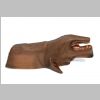 |
 |
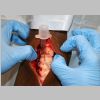 |
Produced by Rescue Critters!
Training model for small animal thoracocentesis and chest tube thoracostomy
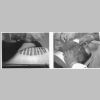 |
By Williamson & Fio Rito 2014: A small animal thoracocentesis and chest tube thoracostomy model has been developed, that allows repetitive practice in a safe, standardised environment. … Student feedback indicated a high degree of satisfaction with the model and the laboratory experience, high perceived value of the case studies in improving learning, and increased confidence to perform the procedures under supervision. This model can replace the use of live animals while students are practising these procedures, improving their technique, and learning the appropriate safeguards used to prevent injuries such as pulmonary trauma.
See Williamson, 2014 for critical evaluation.
Columbia Dentoform® Corporation
Cat skull with teeth and gingiva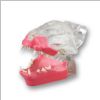 |
Dog skull with teeth and gingiva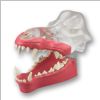 |
They develop and provide material for dentistry training.
From Web site: Make it possible to practice every aspect of dentistry, including tooth extractions, periodontic and prosthodontic techniques, cavity preparation and routine cleanings
Sawbones® veterinary models for surgery
They develop and provide material for surgery training, including orthopedics, intestinal anastomosis, arthroscopy, endoscopy.
SYNBONE AG veterinary models for orthopedic surgery
They develop and provide material for orthopedic surgery training for cats, dogs and horses.
HSVMA Educational Memorial Programs
Information on developing a willed-body (ethically sourced cadaver) program
Using rabbit surgical (neutering) clinics
Description of program to use rabbit neutering clinics to augment student surgical experience
The following includes literature cited above or which is relevant to the development of various skills related to surgery, including outcome assessment. The titles are linked either to a publicly available copy of the document or to a digital object identifier. If there are illustrations which may be publicly viewable, these are also linked, but there is no guarantee that they would be viewable across all platforms.
Aboud, Emad; Suarez, Carlos Ernesto; Al-Mefty, Ossama and Yasargil, M. Gazi 2004 New alternative to animal models for surgical training Alternatives to Laboratory Animals 32(suppl 1):501-507
We developed a new model utilising human cadavers that can replace the use of live anaesthetised animals for surgical training. The vessels in a cadaveric specimen were connected to artificial blood reservoirs. … This method provides a condition that simulates live surgery in terms of bleeding, pulsation and liquid filling of the vascular tree. It is an excellent alternative model and can be applied to the whole cadaver or to a particular cadaveric specimen (head, arm, leg) or to an isolated organ. It is distinctive and of a great practical value for training in a wide range of surgical procedures, Utilising this technique could forever eliminate the use of live anaesthetised animals for surgical training.
This method can also be used for ethically-sourced non-human animal cadavers.
Anderson, Stacy L.; Miller, Lynda; Gibbons, Philippa; Hunt, Julie A.; Roberson, Jerry; Raines, Jeffrey A.; Patterson, Gil and Dascanio, John J. 2021-02-01 Development and Validation of a Bovine Castration Model and Rubric Journal of Veterinary Medical Education 48(1):96-104
 |
 |
We sought to create and validate a surgical bovine castration model consisting of a molded silicone scrotum and testicles to allow students to practice this skill without the use of live animals. … The [model-trained] group had higher performance scores than the [traditionally trained] group… Model training improved students’ performance scores and provided evidence for validation of the model and rubric.
Editor’s comment: Although this may be a ‘humane’ approach to teaching the surgery, there would be no pressing need for the surgery if we did not treat cattle as a source of food and fibre.
Annandale, Annett; Scheepers, Elrien and Fosgate, Geoffrey T. 2020 The effect of an ovariohysterectomy model practice on surgical times for final-year veterinary students’ first live-animal ovariohysterectomies Journal of Veterinary Medical Education 47(1):44-55
 |
 |
…students practicing an OVH on the model felt more confident (92%) and less stressed (73%) when performing their first live-animal OVH. Results suggest that the canine OVH model may be helpful as a clinical training tool and we concluded that the OVH model was effective at decreasing students’ first OVH surgical time.
Anonymous 2012 “Matrix and veterinary science know-how creates a cutting-edge model.” University of Sydney News
The model described in this news item was being developed by Studio Kite.
Anwar, Mohammad; Renner, Norrie and Harris, Malcolm 1989 A simple teaching model for mucoperiosteal flaps and suturing techniques British Dental Journal 166(2):38
Although this is about human dental procedures, the principles should apply to similar veterinary dental procedures. The model is made from easily obtainable plastic and rubber materials and is used to practice various techniques used in minor oral surgery (incision and suturing techniques). The article details how to make the model.
Badman, Märit; Höglund, Katja and Höglund, Odd V. 2016 Student perceptions of the use of a laser pointer for intra-operative guidance in feline castration Journal of Veterinary Medical Education 43(2):222-224
 |
This study showed that laser pointers enhanced verbal guidance given to students during surgery. The suggested mechanism of explanation is that the technology enabled a more precise guidance of location and identification of anatomic structures.
Badman, Märit; Tullberg, Marja; Höglund, Odd V. and Hagman, Ragnvi 2016 Veterinary student confidence after practicing with a new surgical training model for feline ovariohysterectomy Journal of Veterinary Medical Education 43(4):427-433
 |
 |
 |
The results showed that the students rated their confidence level higher after performing feline OHE if they had practiced with the [surgical training model] before surgery. Voluntary written comments revealed that live surgery as a learning situation could have a very negative emotional impact on some students.
Bauer, M.S.; Glickman, N.; Glickman, L.; Toombs, J.P. and Bill, P. 1992. “Evaluation of the effectiveness of a cadaver laboratory during a 4th-year veterinary surgery rotation.” Journal of Veterinary Medical Education 19(3):77-84
In conclusion, the cadaver laboratory as a teaching tool was more effective when used by a particular instructor. … Learning outcomes as measured by grades were not significantly influenced by any variable in our study.
Benato, Livia and Hammond, Jennifer 2018 Rabbit neutering in primary-care education: Insights from a surgical clinic Journal of Veterinary Medical Education 45(1):91-98
We conclude that rabbit surgical clinics offer excellent learning opportunities for undergraduate veterinary students. With prior training in handling and close individual supervision, it is possible to achieve good clinical outcomes and to have a positive impact on the welfare of companion animal populations.
Bowlt, K.L.; Murray, J.K.; Herbert, G.L.; Delisser, P.; Ford-Fennah, V.; Murrell, J. and Friend, E.J. 2011 Evaluation of the expectations, learning and competencies of surgical skills by undergraduate veterinary students performing canine ovariohysterectomies The Journal of Small Animal Practice 52(11):587-594
Buote, Nicole J.; Fransson, Boel and Rishniw, Mark 2024-02-01 Comparison of Attempts Needed for Veterinary Students to Reach Proficiency in a Basic and Advanced Robotic Simulator Task Journal of Veterinary Medical Education 51(1):104-112
The aim of this study was to compare the number of attempts needed for veterinary students to reach proficiency in both a basic and advanced robotic simulator task, and to assess the predictive nature of performance variables. Each student performed a basic and advanced tasks on the Mimic dV-Trainer™ until proficiency was reached. … Continued investigations on robotic simulators should be performed to investigate their use in improving psychomotor skills in veterinary students.
Buyukmihci, Nedim C 2023 Non-violence in Surgical Training
A ‘white paper’ discussing the issue of surgical training in veterinary medical school and providing the student with practical and philosophical arguments to use when faced with a surgical instruction curriculum that is based on forcing all students to harm and kill animals.
Carpenter, Larry G.; Piermattei, Donald L.; Salman, Mowafak D.; Orton, E. Christopher; Nelson, A. Wendell; Smeak, Daniel D.; Jennings, Paul B. and Taylor, Robert A. 1991 A comparison of surgical training with live anesthetized dogs and cadavers Veterinary Surgery 20(6):373-378
The authors compared the results of students learning surgery using live animals or cadavers.
No statistically significant differences could be detected between the two groups [of students, with respect to skill, outcome].
Carroll, Hillary S.; Lucia, Tomasina A.; Farnsworth, Chelsea H.; Hinckley, Michael M.; Zeugschmidt, Eryn L. and Cary, Julie A. 2016 Development of an optional clinical skills laboratory for surgical skills training of veterinary students Journal of the American Veterinary Medical Association 248(6):624-628
During each OCSL session, a variety of surgical training models and cadavers were available for students to practice with. Simple models for students to practice suturing, pedicle ligation, and IV catheter placement were made from surplus hospital stock and inexpensive materials readily available from hardware and craft stores. In addition, 5 to 7 whole or prosected cadavers were typically available for student use during each session. Large animal cadavers were primarily obtained through donation to the veterinary teaching hospital. Canine and feline cadavers were obtained through the CVM’s contract with animal control agencies in Washington state under which animals judged to be unadoptable by individual animal control agencies were euthanized at the agencies in accordance with AVMA and institutional animal care and use guidelines and transported to WSU CVM fresh-frozen. Fresh cadavers from other teaching laboratories were also used when available. All cadaver use adhered to AVMA and institutional animal care and use guidelines for humane use of animals. No animals were euthanized specifically for use in the OCSL.
Casimir, Roslyn; Linn, Lorraine; King, Howard; McKenzie, David; Thompson, Melisa and Perry, R.L. 2022-12-15 Simulation models: another approach to teaching and learning Journal of the American Veterinary Medical Association 261(1):47
 |
Eleven SynDaver canine simulators were purchased for the surgical training program at TUCVM, including one for the anatomy simulation laboratory. … Although synthetic, the canine simulators have the feel and texture of living tissue and contain individual muscles, bones, and organs. The synthetic dog has a complete list of functioning body systems, including a heart with a heartbeat and a circulatory system, and will bleed with surgical incisions. Students in their surgical training program have opportunities to repeat surgical procedures as often as needed to achieve confidence and competency as assessed by the clinician without the risks associated with a live animal. With functioning body systems, clinicians can simulate diseases and medical complications, thus assessing the students’ foundational medical knowledge and ability to make clinical applications to medical treatment and outcomes. The surgical simulations also provide a safe environment where students can explore, practice, and learn from their mistakes. These simulators are ideal, as they emulate real case scenarios.
Chen, Chi-Ya; Elarbi, Mustafa; Ragle, Claude A. and Fransson, Boel A. 2019 Development and evaluation of a high-fidelity canine laparoscopic ovariectomy model for surgical simulation training and testing Journal of the American Veterinary Medical Association 254(1):113-123
Results suggested the [simulated laparoscopic ovariectomy] model may be a useful surgical training tool. Further studies are needed to confirm usefulness of the model in veterinary laparoscopy training.
Clanton, Jesse; Gardner, Aimee; Cheung, Maureen; Mellert, Logan; Evancho-Chapman, Michelle and George, Richard L. 2014 The relationship between confidence and competence in the development of surgical skills Journal of Surgical Education 71(3):405-412
Although involves human medical school training, the principles are applicable to veterinary medical school.
Clevenger, Jaime and Kass, Philip H. 2003 Determinants of adoption and euthanasia of shelter dogs spayed or neutered in the University of California veterinary student surgery program compared to other shelter dogs Journal of Veterinary Medical Education 30(4):372-378
At the University of California, Davis (UCD), shelter dogs are neutered [castration or spay] by veterinary students and then returned to the shelter for adoption. … In this study, pre-adoption neutering increased adoptions without increasing the probability of medical or behavioral euthanasia.
Cruz, Matheus Barbosa Gomes; Costa, Lyana; Carareto, Roberta and de Oliveira Stedile, Simone Tostes 2024-07-01 An Accessible Nephrectomy and Cystotomy Simulator for Use in Teaching Small Animal Surgery Alternatives to Laboratory Animals 52(4):214-223
The aim of this study was to develop and assess the value of a simple nephrectomy and cystotomy simulator that could replace the use of cadavers in surgical practical classes. The simulator, which represented the abdominal cavity, bladder, kidneys, ureter, vessels and adipose tissue, was constructed by using synthetic materials. … The simulator was well accepted by the students, with the best scores achieved for the ureter divulsion and ligation procedures; good results were also recorded for the kidney vessel ligature and urinary bladder suture practice. The scores showed that the simulator provided an acceptable experience during the training process and increased the confidence of the students in performing the procedure.
Dankelman, Jenny 2008 Surgical simulator design and development World Journal of Surgery 32(2):149-155
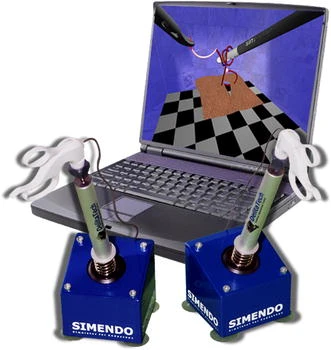 |
 |
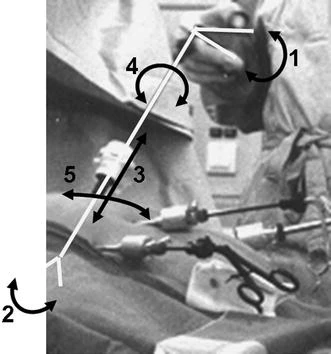 |
Devine, Elizabeth; McCracken, Megan; Miller, Lynda; Miller, Dianna; Anderson, Stacy L. and Hunt, Julie A. 2024-12-01 Development and Validation of an Equine Castration Model and Rubric Journal of Veterinary Medical Education 51(6):834-843
A recumbent equine castration model was created and evaluated using a validation framework consisting of content evidence (expert opinion), internal structure evidence (reliability of scores produced by the accompanying rubric), and evidence of relationship with other variables, specifically the difference in scores between experts and students. … The equine castration model and rubric validated in this study can be used in a low-stress clinical skills environment to improve students’ skills to perform what is otherwise a challenging field procedure. Model use should be followed with live animal practice to complete the learning process.
DeYoung, David J. and Richardson, Daniel C. 1987 “Teaching the principles of internal fixation of fractures with plastic bone models” Journal of Veterinary Medical Education 14(1):30-31
Based on our past experience in numerous live animal fracture fixation laboratories, it is our opinion that the students’ self-confidence is greatly increased after working with the plastic models. Their motor skills and comprehension of the biomechanical principles of fracture fixation and implant application are superior to those resulting from the use of live animal laboratories only.
Elarbi, Mustafa M.; Ragle, Claude A.; Fransson, Boel A. and Farnsworth, Kelly D. 2018 Face, construct, and concurrent validity of a simulation model for laparoscopic ovariectomy in standing horses Journal of the American Veterinary Medical Association 253(1):92-100
 |
 |
 |
Results suggested that the simulation model had face, construct, and concurrent validity, suggesting that it may be useful when training students to perform laparoscopic ovariectomy in standing horses.
Fahie, Maria; Cloke, Amanda; Lagman, Minette; Levi, Ohad and Schmidt, Peggy 2016 Training veterinary students to perform ovariectomy using theMOOSE Spay Model with traditional method versus the Dowling Spay Retractor Journal of Veterinary Medical Education 43(2):176-183

|
 |
This study endeavored to compare two methods of teaching OVE on a model based on assessment of procedure time and skill performance scores.
Copy may be available from: ResearchGate
Filliquist, Barbro; Kapatkin, Amy S.; Vernau, Karen M.; Nakatani, Jamie Y.; Chou, Po-Yen and Ilkiw, Jan E. 2022-12-01 Training Surgical Residents Utilizing an Animal Shelter Fracture Program Journal of Veterinary Medical Education 49(6):778-784
Working relationships between veterinary medical teaching hospitals, animal shelters, and rescue groups are one way to increase veterinary students’ and residents’ hands-on training. The goal of this study is to describe the use of a shelter fracture program to improve the surgical skills of surgical residents. … Surgical resident and student surveys show that this program contributes to their knowledge, skills, and confidence in treating fracture patients. A successful cooperative program provides advanced surgical fracture treatment of shelter animals, improving animals’ quality of life as well as surgical residents’ and veterinary students’ skills training.
Fransson, Boel A. and Ragle, Claude A. 2010 Assessment of laparoscopic skills before and after simulation training with a canine abdominal model Journal of the American Veterinary Medical Association 236(10):1079-1084
 |
 |
 |
…training with a canine abdominal model could increase skills scores for individuals without previous laparoscopic experience.
You may be able to obtain a copy from: ResearchGate
Fransson, Boel A.; Ragle, Claude A.; Mickas, Matthew M.; Martin, Kyle W. and Karn, Krystina N.L. 2023-06-01 Ability to Perform Laparoscopic Intra- and Extracorporeal Suture Ligations in a Live Canine Ovariectomy Model after Simulation Training Journal of Veterinary Medical Education 50(3):305-313
Extensive simulation training including suturing may contribute toward surgery residents being able to perform complex laparoscopic procedures.
Freeman, Lynetta J.; Ferguson, Nancy; Litster, Annette and Arighi, Mimi 2013 Service learning: Priority 4 Paws mobile surgical service for shelter animals Journal of Veterinary Medical Education 40(4):389-396
Performing spays and neuters at a humane society is a unique form of service learning in which students develop greater confidence in performing anesthesia and surgery as well as a better understanding of the scope of pet homelessness. … The Priority 4 Paws program is an example of an integrated, community-based service-learning opportunity that not only helps to improve the surgical skills of veterinary students but also helps to meet an identified community need.
You may be able to obtain a copy from: ResearchGate
Freeman, Lynetta J.; Huse, David; Lee, Rebecca; Inoue, Tomo; Weil, Ann B. and Constable, Peter D. 2014 Teaching veterinary anesthesia and surgery: The impact of instructor availability on anesthesia, operative, and recovery times in dogs undergoing ovariohysterectomy or castration Journal of Veterinary Medical Education 41(4):390-399
Using dedicated instructors to teach OVH and castration to third-year veterinary students decreased overall anesthesia time by 36 to 49 minutes for OVH and 29 to 32 minutes for castration. A teaching model of dedicated instructors requires excellent coordination between surgeons and anesthesiologists to ensure that a similar number of animals can undergo procedures in the time allotted for teaching.
You may be able to obtain a copy from: ResearchGate
García González, Melissa; Pérez Rivero Cruz y Celis, Juan José;Heuze de Icaza, Ivonne Michelle and Lozada Gallegos, Ángel Raymundo 2024-11-01 Assessment of a Low-cost Canine Uterine Simulator as a Tool for Teaching the Ovariohysterectomy Technique to Veterinary Students Alternatives to Laboratory Animals 52(6):316-325
 |
 |
This low-cost simulator is ideal for training veterinary students in the early stages of surgical learning, as it effectively facilitates learning the OVH procedure without the use of live animals.
Gates, M. Carolyn; Littlewood, Katherine E.; Kongara, Kavitha; Odom, Thomas F. and Sawicki, Robert K. 2020 Guidelines for implementing a low-cost volunteer desexing skills training program for veterinary and veterinary technology students Journal of Veterinary Medical Education 47(1):27-38
At the Massey University School of Veterinary Science, we recently established an innovative extracurricular volunteer program designed to have students teaching other students how to perform different elements of desexing procedures as they progress through their degree.
Gibbons, Philippa; Koziol, Jennifer; Roof, Clinton; Chambers, Conner; Awosile, Babafela and Dascanio, John 2024-12-01 Development and Validation of a Uterine Prolapse, Epidural, and Vaginal Suture Model Journal of Veterinary Medical Education 51(6):753-761
The objective of this study was to develop a model that represents each step of the process of correcting a uterine prolapse and to perform a validation study of the model and rubric used to score performance using a skill comparison between experienced veterinarians and novices (students). The model was designed and built, and 27 students and 18 bovine veterinarians were recruited to participate in the evaluation of this model. … There was no significant difference between the scores of veterinarians and veterinary students. However, there was an association with an excellent level of global rating scores for veterinarians while the veterinary student participants were associated with borderline satisfactory to good competency levels except for the epidural.
Goff, Barbara A.; Lentz, Gretchen M.; Lee, David; Fenner, Dee; Morris, Jamie and Mandel, Lynn S. 2001 Development of a bench station objective structured assessment of technical skills Obstetrics and Gynecology 98(3):412-416
The authors demonstrated that inanimate models for assessing the skills of surgeons in the field of human gynecology and obstetrics were more reliable as to outcome as well as substantially more economical.
Gopinath, Deepa; McGreevy, Paul D.; Zuber, Richard M.; Klupiec, Corinna; Baguley, John and Barrs, Vanessa R. 2012 Developments in undergraduate teaching of small-animal soft-tissue surgical skills at the University of Sydney Journal of Veterinary Medical Education 39(1):21-29
 |
OHE [ovariohysterectomy] is the ideal procedure to teach basic surgical skills such as instrument and suture handling, hemostasis, and gentle tissue handling. It is a prophylactic procedure generally performed on all shelter animals before re-homing. Therefore, theoretically at least, large numbers of animals should be available as learning opportunities to allow students to perform this procedure repeatedly at spay/neuter clinics.
In the last decade, veterinary teaching institutions world-wide have increasingly recognized that the ability to perform any surgical procedure directly reflects the student’s ability to perform a collection of individual skills combined with their possession of sound scientific knowledge.
Looking to the future, we aim to further incorporate surgical models and simulators, such as DASIE and the newly developed OSM [ovariohysterectomy simulator model], as significant tools for the teaching of basic surgical skills. The earlier implementation of these may be desirable to achieve greater vertical integration, concurrent with the teaching of veterinary anatomy and physiology. A clinical skills laboratory is being established to provide fourth-year students with opportunities to use surgical models and simulators as needed.
You may be able to obtain a copy from: ResearchGate
Greenfield, Cathy L.; Johnson, Ann L.; Arends, Mark W. and Wroblewski, Andrzej J. 1993 Development of parenchymal abdominal organ models for use in teaching veterinary soft tissue surgery Veterinary Surgery 22(5):357-362
Models of the canine spleen, kidney, and liver were made from soft plastic to simulate the organs of the live animal as closely as possible in appearance and tissue handling properties. Each organ model was independently evaluated by five small animal surgeons who performed several common surgical procedures on each model. All models had a realistic appearance and, with the exception of one tissue handling problem with the kidney model, and one with the liver model, tissue handling properties of the models were comparable to those of the organs in the live animal. All models were useful for teaching each of the procedures evaluated.
We believe that veterinary students will develop better surgical skills using realistic soft tissue models as an adjunct to live animal training than they can using traditional methods alone.
Greenfield, C.L.; Johnson, A.L.; Smith, C.W.; Marretta, S.M.; Farmer, J.A. and Klippert, L. 1994 Integrating alternative models into the existing surgical curriculum Journal of Veterinary Medical Education 21(1):23-27
At The University of Illinois, we have made humane issues a priority in our surgical teaching program and we have taken a pro-active attitude.
Over the next few years, our surgical laboratory curriculum will continue to evolve to the point of having no nonsurvival surgical laboratories. The elective neutering procedures on humane shelter animals will be used for all instruction of live-animal surgery and postoperative patient care during the 3rd-year surgical laboratories.
Greenfield, Cathy L.; Johnson, Ann L.; Schaeffer, David J. and Hungerford, Laura L. 1995 Comparison of surgical skills of veterinary students trained using models or live animals Journal of the American Veterinary Medical Association 206(12):1840-1845
Found that there was no significant difference between traditionally trained students for the most part.
Griffon, Dominique J.; Cronin, Paul; Kirby, Barbara and Cottrell, David F. 2000 Evaluation of a hemostasis model for teaching ovariohysterectomy in veterinary surgery Veterinary Surgery 29(4):309-316
The authors compared the skills level of students using a model versus cadavers.
The model was more effective than cadavers in teaching basic surgical skills and ovariohysterectomy in dogs.
Grimes, Janet A.; Appleton, Kate L.; Moss, Lydia A. and Bullington, Anna-Claire M. 2021-12-01 A Simulated Tumor for Teaching Principles of Surgical Oncology for Biopsy and Excision of Skin and Subcutaneous Masses to Veterinary Students Journal of Veterinary Medical Education 48(6):636-639
 |
 |
 |
 |
A gelatin-based simulated tumor was injected into the subcutaneous space in two different sites in canine cadavers. Students then practiced incisional biopsy and wide excision of a subcutaneous mass. Students were able to appropriately perform both techniques using the simulated tumors. When the deep margin was not clean on the wide excision, students were able to understand the error by identifying the simulated tumor, reinforcing the concept of obtaining an appropriate deep fascial plane. In summary, this gelatin-based simulated tumor technique was cost-effective, easy to perform, and effective for the teaching laboratory.
Holmberg, D.L.; Cockshutt, J.R. and Basher, A.W.P. 1993 Use of a dog abdominal surrogate for teaching surgery Journal of Veterinary Medical Education 20(2):61-62
The authors found DASIE to be an effective alternative for preparing students for live surgery. It was well received by the students.
Howe, Lisa M. and Slater, Margaret R. 1997 “Student assessment of the educational benefits of a prepubertal gonadectomy program (preliminary findings)” Journal of Veterinary Medical Education 24(1):12-17
Results of a student questionnaire indicate that the addition of these programs enhances their education experience in several ways including: 1) refinement of surgical skills in certain areas including gentle tissue handling and hand-eye coordination; 2) exposure and practice in perioperative and anesthetic management of pediatric patients; 3) increased awareness of the functions, goals, and activities of humane organizations; and 4) increased understanding of the pet overpopulation problem and the unique role of the veterinarian in combating this problem.
Howe, Lisa M.; Boothe, Harry W.; August, John R.; Bice, Kathy L. and Medicus, Karen L. 1998 “Using community-based service learning projects to improve surgical instruction” Journal of Veterinary Medical Education 25(2):12-15
Recently, the service learning program has been expanded to support the laboratory portion of a required third-year surgery course. The mechanics of both the fourth- and third-year service learning projects are described in detail in this article. Additionally, the key components of successful service learning programs are discussed, as are the benefits derived from the service learning projects at Texas A&M University.
Hunt, Julie A.; Heydenburg, Matthew; Kelly, Christopher K.; Anderson, Stacy L. and Dascanio, John J. 2020 Development and validation of a canine castration model and rubric Journal of Veterinary Medical Education 47(1):78-90
 |
 |
 |
The canine castration model facilitated cost-efficient practice in a safe environment in which students received instructor feedback and learned through experience without the risk of negatively affecting a patient’s well-being. The strong correlation between model and live animal performance scores suggests that the model could be useful for mastery learning.
Hunt, Julie A.; Heydenburg, Matthew; Anderson, Stacy L. and Thompson, R. Randall 2020-05-30 Does virtual reality training improve veterinary students’ first canine surgical performance? The Veterinary Record 186(17):562
When VR training was added to an already comprehensive surgical skills curriculum, students watched VR videos for a median of 90 min. Groups did not differ in surgical performance scores or time.
Hunt, Julie A.; Anderson, Stacy L.; White, Julianne; Kelly, Christopher K. and Spangler, Dawn. 2021-02-01 The Impact of Extracurricular Surgical Experience on Veterinary Students’ Performance of Canine Ovariohysterectomy and Orchidectomy in a Clinical Skills Curriculum Journal of Veterinary Medical Education 48(1):105-114
Our results suggest that extracurricular surgical experiences may not impart a long-term improvement on performance scores or surgical time during students’ first surgery of their veterinary curriculum. Additional research is necessary to clarify how model training and extracurricular surgical experiences on live animals interact to affect students’ subsequent surgical performance.
Hunt, Julie A.; Rogers-Scarlett, Susan; Schmidt, Paul; Thompson, R. Randall; Gilley, Alexandra; Devine, Elizabeth; Kelly, Christopher K. and Anderson, Stacy 2023-06-01 Validation of a Rubric Used for Skills-Based Assessment of Veterinary Students Performing Simulated Ovariohysterectomy on a Model Journal of Veterinary Medical Education 50(3):327-336
These data support validation of the simulated OVH rubric.
Hunt, Julie A.; Gilley, Robert S.; Gilley, Alexandra; Thompson, R. Randall and Anderson, Stacy L. 2024-02-01 Simulating Ovariohysterectomy: What Type of Practice Promotes Short- and Long-Term Skills Retention? Journal of Veterinary Medical Education 51(1):122-129
This study sought to determine the ideal distribution of training sessions to improve short- and long-term retention of the skills necessary to perform a simulated ovariohysterectomy (OVH). … These findings suggest that if educators are seeking maximal performance at a single time point, scheduling instructional sessions on a weekly basis prior to that time would be superior to monthly sessions, but if educators are concerned with long-term retention of skills, scheduling sessions on either a weekly or monthly basis would accomplish that purpose.
Johnson, Ann L. and Farmer, James A. 1989 “Evaluation of traditional and alternative models in psychomotor laboratories for veterinary surgery” Journal of Veterinary Medical Education 16(1):11-14
The use of large and in some cases unrealistic models were superior to live animals for demonstrating basic concepts and allowing the students to gain basic skills. … Students readily accepted alternative models as long as clinical relevance had been demonstrated by the instructor.
Basic psychomotor skills that are essential to the surgeon can be learned with inanimate models. In addition, motor proficiency can be achieved with repetition on models, making the use of models a superior alternative to live animals for learning basic motor skills.
Johnson, Ann L. and Farmer, James A. 1990 “Teaching veterinary surgery in the operating room” Journal of Veterinary Medical Education 17(1):10-12
Discusses the methods of teaching surgery using patients.
With increasing curtailment of the use of live animals in wet labs due to pressure from animal-rights activists and to escalating costs of such animals, the importance of maintaining high-quality instruction and effective risk management in the OR is likely to increase. This paper, based on the results of an interdisciplinary, formative evaluation of teaching of veterinary surgery in the OR, suggests ways of doing so.
Johnson, A.L.; Harari, J.; Lincoln, J.; Farmer, J.A. and Korvick, D. 1990 “Bone models of pathological conditions used for teaching veterinary orthopedic surgery” Journal of Veterinary Medical Education 17(1):13-15
Bone models simulating radius curvus and a femoral nonunion were developed. The models were used successfully in senior student orthopedic surgery rotations and in a continuing education laboratory. The models were ideal for demonstrating and teaching preoperative planning, operative principles and procedures, and postoperative results of corrective osteotomies to veterinary students, interns, residents, practitioners, and clients.
Kennedy, Katie C.; Tamburello, Kathereen R. and Hardie, Robert J. 2011 Peri-operative morbidity associated with ovariohysterectomy performed as part of a third-year veterinary surgical-training program Journal of Veterinary Medical Education 38(4):408-413
Based on the low rate of major and, to a lesser extent, minor complications reported in the present study and considering the relatively low level of intervention and assistance required of faculty during the lab sessions, it would appear that students in this program are reasonably well prepared for the live-animal OVH procedure. However, the extent to which the complication rate for one particular procedure actually correlates with overall surgical competency is not known. Perhaps an even more important question to consider is whether or not OVH does actually involve the spectrum of psychomotor skills necessary to be proficient in basic surgical procedures. In this institution, we use the OVH as a common procedure from which to teach multiple basic surgical principles and, in this environment, the procedure acts as both a surrogate for other surgical procedures and a sentinel for highlighting the strengths and weaknesses of novice surgeons, allowing us to continually improve the fundamental training within the confines of an already overcrowded curriculum. Currently, there is no universal standard in surgical training or agreement as to which surgical skills should make up the core clinical competencies and, until such time, course coordinators of other institutions are encouraged to conduct similar studies so that outcomes can be compared and best practices can be shared as we work toward determining the ideal level and methods of training necessary for instilling core surgical competencies.
Kreisler, Rachael E.; Shaver, Stephanie L. and Holmes, John H. 2018 Outcomes of elective gonadectomy procedures performed on dogs and cats by veterinary students and shelter veterinarians in a shelter environment Journal of the American Veterinary Medical Association 253(10):1294-1299
Langebæk, Rikke; Toft, Nils and Eriksen, Thomas 2015 The SimSpay—Student perceptions of a low-cost build-it-yourself model for novice training of surgical skills in canine ovariohysterectomy Journal of Veterinary Medical Education 42(2):166-171
 |
In the Department of Veterinary Clinical and Animal Sciences of the University of Copenhagen, a low-cost build-it-yourself model, the SimSpay, was developed for novice training of surgical skills in canine ovariohysterectomy. The model did not require the use of trained technical staff or costly, hard-to-source supplies. The SimSpay was developed and implemented in the clinical veterinary curriculum in 2013. … By increasing students’ perceived levels of competence, confidence, and anatomic knowledge, the low-fidelity SimSpay is a useful, low-cost learning tool for teaching ovariohysterectomy.
You may be able to obtain a copy from: ResearchGate
Langebæk, Rikke; Tanggaard, Lene; Toft, Nils and Berendt, Mette 2020 Using creativity as an educational tool in veterinary surgery: Students’ perceptions and surgical performance Journal of Veterinary Medical Education 47(1):91-99
The intervention group showed a significantly better performance and needed significantly less help with the surgical complication than the control group students. … Our study results thus indicate that an educational tool which stimulates creative thinking can promote reflection, creativity, and self-efficacy in novice surgeons without compromising surgical performance.
Laws, Abigail Cox; Traverson, Marine; Wood, Maddie and Harrysson, Ola L.A. 2024-06-01 Novel 3D Custom-Made Silicone Tumor Model as a Support for Teaching Surgical Oncology Principles Journal of Veterinary Medical Education 51(3):394-404
We have developed a three-dimensional (3D) custom-made silicone soft tissue tumor model using 3D-printed molds derived from canine soft tissue sarcoma computed tomography images. This novel teaching model allows users to apply surgical oncology principles and perform basic technical tasks such as incisional biopsy, margin demarcation, marginal and wide surgical excision, and inking of surgical margins. A large cohort of students in addition to a small number of professional veterinarians at different levels of specialty training followed the laboratory guidelines and evaluated the simulated tumor model based on a qualitative survey. All participants were able to successfully complete the practical training. The model also allowed the students to identify and correct technical errors associated with biopsy sampling and margin dissection, and to understand the clinical impacts related to those errors. … This model development emphasizes the efficacy of alternative non-cadaveric laboratory teaching tools and could become a valuable aid in the veterinary curricula.
Lencioni, Rachael D.; Ragle, Claude A.; Kinser, Mathew L.; Coffey, Todd and Fransson, Boel A. 2017 Effect of simulator orientation during skills training on performance of basic laparoscopic tasks by veterinary students Journal of the American Veterinary Medical Association 251(10):1196-1201
Because veterinary surgeons may be required to treat patients in various positions, development of laparoscopic training models to simulate the vertical plane is recommended.
Levi, Ohad; Kass, Philip H.; Lee, Lyon Y.; Cantrell, Valerie M.; Clark, David E. and Griffon, Dominique J. 2015 Comparison of the ability of veterinary medical students to perform laparoscopic versus conventional open ovariectomy on live dogs Journal of the American Veterinary Medical Association 247(11):1279-1288
 |
 |
 |
 |
All training was done using inanimate skills development models or simulators followed by performing surgery on dogs who were going to be adopted from a shelter.
The training programs were effective in improving student confidence and skills in laparoscopic ovariectomy. Results of this study suggested that veterinary medical students, with assistance from an instructor, may be taught to perform laparoscopic ovariectomies with performance equivalent to that for students performing open ovariectomies.
Levi, Ohad; Michelotti, Kurt; Schmidt, Peggy; Lagman, Minette; Fahie, Maria and Griffon, Dominique 2016 Comparison between training models to teach veterinary medical students basic laparoscopic surgery skills Journal of Veterinary Medical Education 43(1):80-87
 |
 |
 |
 |
In conclusion, the low-cost tablet trainer and the more expensive box trainer were similarly effective in preparing pre-clinical veterinary students to perform basic laparoscopic skills on a model.
MacArthur, Sandra L.; Johnson, Matthew D. and Colee, James C. 2021-02-01 Effect of a Spay Simulator on Student Competence and Anxiety Journal of Veterinary Medical Education 48(1):115-128
 |
 |
 |
 |
 |
 |
A spay simulator was developed to provide veterinary students at the University of Florida College of Veterinary Medicine a reusable, inexpensive, and error-enabled device for self-practice in anticipation of a live canine ovariohysterectomy. … The results of this study demonstrate that this low-fidelity spay simulator has a unique place in student surgical training, producing novice surgeons with increased perceived competence and knowledge of anatomy following spay simulation training and live animal surgery.
Martinsen, Siri and Jukes, Nick 2007 Ethically sourced animal cadavers and tissue: Considerations for education and training Alternatives to Animal Testing and Experimentation 14:265-268
Discusses the ethical and practical aspects of using cadavers, particularly in veterinary medical anatomy and surgical training.
McGowan, Rachel Z.; Brookes, Victoria J.; Jermyn, Kieri; Stanley, Felicity and Rotne, Randi 2023-12-01 Single Pedicle Advancement Flap Models for Teaching Veterinary Reconstructive Surgical Techniques Journal of Veterinary Medical Education 50(6):703-712
…a single pedicle advancement flap model was designed. The design consisted of a silicone model secured by a plate, providing tension…Results suggest that the students’ reconstructive surgical technique improved after a single practice session and that the single pedicle advancement flap model can be used synergistically with other teaching methods.
Millard, Heather A. Towle; Millard, Ralph P.; Constable, Peter D. and Freeman, Lyn J. 2014 Relationships among video gaming proficiency and spatial orientation, laparoscopic, and traditional surgical skills of third-year veterinary students Journal of the American Veterinary Medical Association 244(3):357-362
Results of this study indicated video game performance of third-year veterinary students was predictive of laparoscopic but not traditional surgical skills, suggesting that laparoscopic performance may be improved with video gaming experience.
Ng, Z.Y.; Honeyman, C.; Lellouch, A.G.; Pandya, A. and Papavasiliou, T. 2021-12-15 Smartphone-based DIY home microsurgical training with 3D printed microvascular clamps and Japanese noodles European Surgical Research
 |
The perceived advantages of this model are numerous. Not only does it comply with the 3Rs of simulation-based training, it can also reduce the associated costs of training by up to a hundred-fold or more when compared to a traditional rat course, and potentially, be extended to low-middle income countries (LMICs) without routine access to microsurgical training for capacity development. That it can be utilised remotely also bodes well with the current limitations on face to-face training due to COVID restrictions and lockdowns.
Noyes, Julie A.; Carbonneau, Kira J. and Matthew, Susan M. 2022-02-01 Comparative Effectiveness of Training with Simulators Versus Traditional Instruction in Veterinary Education: Meta-Analysis and Systematic Review Journal of Veterinary Medical Education 49(1):25-38
Overall, the results indicate that simulator training in veterinary education can be effective for knowledge and clinical skill outcomes.
Pavletic, Michael M.; Schwartz, Anthony; Berg, John and Knapp, Deirdre 1994 An assessment of the outcome of the alternative medical and surgical laboratory program at Tufts University Journal of the American Veterinary Medical Association 205(1):97-100
The authors evaluated student learning for various diagnostic and surgical procedures using cadavers.
[surgical procedures assessed were]: Ovariohysterectomy, Castration, Laceration Abscess, Laparotomy, Gastrotomy, Eyelid surgery, Cystotomy, Intestinal anastomosis, Splenectomy, Gastric torsion/Gastropexy, Simple fracture repair, Cast/Splint application, Thoracotomy, Other
Medical and diagnostic procedures assessed were: Transtracheal aspirate, Urinary catheterization (male), Urinary catheterization (female), Bone marrow aspiration, Venipuncture, Needle aspirate, True cut needle biopsy, Ophthalmic examination, Otic examination, Cerebrospinal fluid tap, Cystocentesis, Venous catheter placement, Other
Our results suggest that use of cadavers during the third-year laboratory program, when supplemented with additional clinical training during the fourth year, can provide training comparable to that provided in a conventional laboratory program.
Peck, Charlie; Prabert, Josefine; Enlund, Karolina Brunius and Höglund, Odd V. 2023-08-01 Confidence among Veterinary Students to Perform Canine Orchiectomy: The Impact of Live Animal Surgical Clinical Training Journal of Veterinary Medical Education 50(4):475-481
The results showed a statistically significant increase in confidence to perform COEs [canine orchiectomies] in the group that had previously performed or observed COE compared with the group that had neither performed nor observed the procedure. In conclusion, veterinary students’ participation in COEs significantly contributed to their clinical confidence to perform the procedure.
Roe, Matthew K.; Matyjaszek, Sarah; Stein, Amy; Sullins, Kenneth and Brosnahan, Margaret M. 2024-10-01 Exploring the Benefits of Stroboscopic Technology and Guided Visualization in Teaching Suturing Techniques to Veterinary Medicine Students Journal of Veterinary Medical Education 51(5):620-629
There was no significant difference in technique scores for any group with any pattern at any time point. Stroboscopic training may result in faster suturing times without deterioration of suturing technique.
Romero, Camilo; Mendoza, Germán D.; Martínez, José Antonio; Hernández, Pedro A.; Magallón, Elena and del Carmen García, Adelfa 2013 Evaluation of psychomotor skills acquired for surgery by veterinary students using biological simulators Interciencia 38(5):377-381
The authors compared students learning the following: ligature, synthetic skin, enterotomy, enterectomy, gastrostomy, cystotomy, endotracheal tube placement, permanent intravenous catheter. They used organs from animals killed at a slaughterhouse. Although this type of alternative would be objectionable to many, the results demonstrated that the students could acquire skills from non-living tissue. This adds additional support to cadaver-based training (with the hope that the cadavers would be ethically-sourced).
The students were subsequently grouped into five teams (surgeon, assistant surgeon, instrumentalist, anesthetist and circulating) and performed surgical procedures using biological simulators (pig organs) that were obtained from animals slaughtered humanely in accordance with the Official Mexican Standard (NOM-033-ZOO-1995) that regulates the slaughter of domestic animals and wildlife.
Rubeis, Giovanni and Steger, Florian 2018 Is live-tissue training ethically justified? An evidence-based ethical analysis Alternatives to Laboratory Animals 46(2):65-71
A close examination of the evidence base for the presumed advantages of [live-tissue training] showed that it is not superior to simulation-based methods in terms of educational benefit. Since credible alternatives that do not cause harm to animals are available, we conclude that [live-tissue training] on animal models is ethically unjustified.
Samper, Bailey A.; Rowe, Joshua A. and Williams, Ryan B. 2024-10-01 Companion Animal Cadaver Donation for Teaching Purposes at Veterinary Medicine Colleges: A Discrete Choice Experiment Journal of Veterinary Medical Education 51(5):560-568
…our results suggest that younger pet owners, individuals with more formal education, and individuals with positive relationships with their current veterinarian are most likely to participate in a donation program. Concerningly, however, dog owners were somewhat less likely than other respondents to participate. The return of pet ashes was the most important attribute to respondents, suggesting that cadaver donation administrators should consider inclusion of this service to maximize participation.
Scalese, Ross J. and Issenberg, Barry 2005 Effective use of simulations for the teaching and acquisition of veterinary professional and clinical skills Journal of Veterinary Medical Education 32(4):461-467
Silva, R.M.G.; Matera, J.M. and Ribeiro, A.A.C.M. 2007 New alternative methods to teach surgical techniques for veterinary medicine students despite the absence of living animals. Is that an academic paradox? Anatomia, Histologia, Embryologia 36(3):220-224
Discusses use of a better method of preserving cadavers for use in surgery.
Smeak, Daniel D. 2007 Teaching surgery to the veterinary novice: The Ohio State University experience Journal of Veterinary Medical Education 34(5):620-627
 |
 |
 |
The author describes the positive experience at The Ohio State University in doing away with terminal surgery labs.
This article describes a successful and ethical surgical training program used at the Ohio State University College of Veterinary Medicine (OSU-CVM). This program provides early exposure to skills training using surgical simulators and auto-tutorials, ensures that basic skills are mastered before students are exposed to cadaver practice, and requires application of model-based skills to cadavers, with final matriculation to intensive exposure to multiple live-animal procedures via a collaborative surgery program with a local shelter.
Smeak, Daniel D. 2008 Teaching veterinary students using shelter animals Journal of Veterinary Medical Education 35(1):26-30
Cooperative efforts between animal shelters and veterinary schools can provide crucial opportunities for outreach teaching initiatives, particularly for teaching medical and surgical skills. Prior to establishing a program, it is necessary to establish workable policies about euthanasia, what conditions warrant rehabilitation, and how prescription drugs are dispensed and to organize a medical records system. The shelter instructor should have a comprehensive understanding of shelter issues and must have the patience and interest to teach students on the floor daily. Shelter faculty should be incorporated into core clinical teaching programs to keep them current and engaged and to provide for continued learning and growth in their interest areas. These measures will help sustain shelter collaboration and retain teachers who provide vital instruction in our clinical training programs.
Smeak, Daniel D.; Hill, Lawrence N.; Beck, Marian L.; Shaffer, C. Allen and Birchard, Stephen J. 1994 Evaluation of an autotutorial-simulator program for instruction of hollow organ closure Veterinary Surgery 23(6):519-528
Although the students using the simulator prior to animals did not appear to have more confidence, it seemed that the overall results were similar to students using animals only.
This AT [autotutorial]/simulator program evidently does not significantly influence students overall gastrotomy closure technique versus traditional instruction methods. Several factors may help explain these results. The hollow organ model did not satisfactorily simulate live stomach tissue; the material was more fragile and stiff and suture cut-out was a problem even with appropriate suture tension and technique. Despite these obstacles, however, the model combined with AT instruction was effective for teaching several important aspects of gastrotomy closure, including needle placement. instrument usage, proper tissue inversion, and methods to minimize instrument handling of tissue.
Snowden, Karen; Bice, Kathryn; Craig, Tom; Howe, Lisa; Jarrett, Melissa; Jeter, Elizabeth; Kochevar, Deborah; Simpson, R. Bruce; Stickney, Mark; Wesp, Ashley; Wolf, Alice M. and Zoran, Debra 2008 Vertically integrated educational collaboration between a college of veterinary medicine and a non-profit animal shelter Journal of Veterinary Medical Education 35(4):637-640
The program represents a creative approach to veterinary training that conscientiously uses animal resources in a positive fashion. We believe that this is a successful partnership between a state-supported veterinary college and a non-profit shelter that benefits both agencies. We encourage other veterinary colleges to explore similar partnership opportunities to provide optimal training for professional students while using animal resources efficiently.
Spindel, Miranda E.; MacPhail, Catriona M.; Hackett, Timothy B.; Egger, Erick L.; Palmer, Ross H.; Mama, Khursheed R.; Lee, David E.; Wilkerson, Nicole and Lappin, Michael R. 2008-12-01 A lifesaving model: Teaching advanced procedures on shelter animals in a tertiary care facility Journal of Veterinary Medical Education 35(4):553-558
The results suggest that collaboration between a tertiary-care facility and a humane shelter can be used successfully to teach advanced procedures and to save homeless animals. The project demonstrated that linking a veterinary teaching hospital’s resources to a humane shelter’s needs did not financially affect either institution. It is hoped that such a program might be used as a model and be perpetuated in other communities.
Sun, Jessica 2025-01-01 Temporary palatopexy procedure for brachycephalic obstructive airway crisis in dogs Journal of the American Veterinary Medical Association 263(1):1
Tan, Christopher; Basa, Rachel; Bennett, Peter; Hannan, Neil; Walsh, William R. and Bellenger, Christopher 2018 Teaching tip: Simulated tumors as an aid to teaching principles of surgical oncology Journal of Veterinary Medical Education 45(2):250-254
 |
 |
 |
Tefera, Melaku 2011 Surgical dummy: a surrogate to live animal in teaching veterinary surgery Ethiopian Veterinary Journal 15(2):1-10
The author reported on using dead animal organs or bodies in order to prepare the students for live animal surgery on patients. In some cases, organs from animals killed at a slaughterhouse were used. Although this type of alternative would be objectionable to many, the results demonstrated that the students could acquire skills from non-living tissue. This adds additional support to cadaver-based training (with the hope that the cadavers would be ethically-sourced).
Tobias, Karen M. and Bailey, Misty R. 2020-12-01 Veterinary Student Self-Assessment of Basic Surgical Skills as an Experiential Learning Tool Journal of Veterinary Medical Education 47(6):661-667
Correlation between self-assessment and practical examination results suggests instructors may use these self-assessments to detect students who need extra practice or instruction.
White, Karl K.; Wheaton, Lynn G. and Greene, Stephen A. 1992 “Curriculum change related to live animal use: A four-year surgical curriculum” Journal of Veterinary Medical Education 19(1):6-10
The authors describe their program at that time (prior to 1992), which involved two modalities, one which involved traditional terminal animal labs and the other which used cadavers.
The small animal surgical faculty have noted that students from the alternative surgical laboratory program are more timid and hesitant the first time they incise living tissue. This hesitancy is only apparent on the first live tissue surgery. In all other segments of the 4th-year small animal surgery and anesthesia rotations, including patient care, the alternative students perform on a par with the students from the standard laboratory experience.
Williamson, Julie A. 2014 Construct validation of a small-animal thoracocentesis simulator Journal of Veterinary Medical Education 41(4):384-389
You may be able to obtain a copy of the paper from: ResearchGate
Williamson, Julie A. and Fio Rito, Robin M. 2014 Development of a training model for small animal thoracocentesis and chest tube thoracostomy Alternatives to Laboratory Animals 42(3):201-205
Williamson, Julie A.; Brisson, Brigitte A.; Anderson, Stacy L.; Farrell, Robin M. and Spangler, Dawn 2019 Comparison of 2 canine celiotomy closure models for training novice veterinary students Veterinary Surgery 48(6):966-974
The acquisition of surgical skills required to perform celiotomy closure in companion animals occurs similarly well on models made of foam and fabric or of silicone, providing flexibility in model selection.
Williamson, Julie A.; Johnson, Jennifer T.; Anderson, Stacy; Spangler, Dawn; Stonerook, Michael and Dascanio, John J. 2019 A randomized trial comparing freely moving and zonal instruction of veterinary surgical skills using ovariohysterectomy models Journal of Veterinary Medical Education 46(2):195-204
These results suggest that students accept either instructional method, but most instructors prefer to be assigned to a small group of students. Surgical skills were learned similarly well by students in both groups, although assigned instructors were more accurate at identifying at-risk students, which could prove beneficial if early intervention measures can be offered.
Woon, Siaw-Yean 2011-01-01 A veterinary student’s perspective on educational animal use and the potential for humane alternatives Altex Proceedings 1/12:377-385
One alternative discussed and illustrated here is the University of Sydney Faculty of Veterinary Science’s ovariohysterectomy simulator model. This was being developed by Studio Kite.
Yushchenko, Anya; Berreville, Olivier; Wright, Nick; White, Liz and Sullivan, Erika 2011-01-01 Elimination of live terminal surgeries in Canadian veterinary practice Altex Proceedings 1/12():395-397
Discusses the elimination of terminal surgeries in the Veterinary Skills Training and Enhancement Program (VSTEP). The latter is a program at the Ontario Veterinary College for upgrading the skills of foreign-trained veterinarians living in Canada.
Zeugschmidt, Eryn L.; Farnsworth, Chelsea H.; Carroll, Hillary S.; Lucia, Tomasina A.; Hinckley, Michael M.; Gay, John M. and Cary, Julie A. 2016 Effects of an optional clinical skills laboratory on surgical performance of third-year veterinary students Journal of the American Veterinary Medical Association 248(6):630-635
Results suggested that attendance in the OCSL sessions was associated with improvements in surgical performance, as reflected in faster total surgery and incision closure times while performing an ovariohysterectomy during the third-year surgery course.
Updated 2025-01-20
